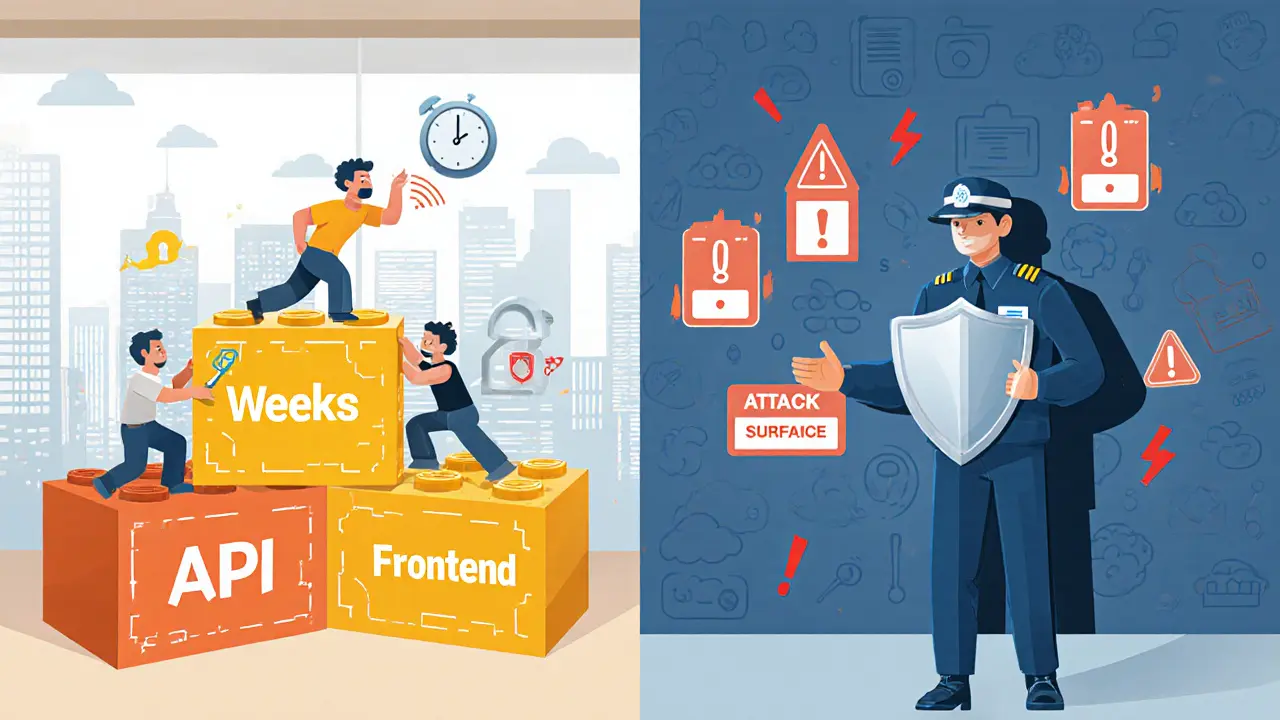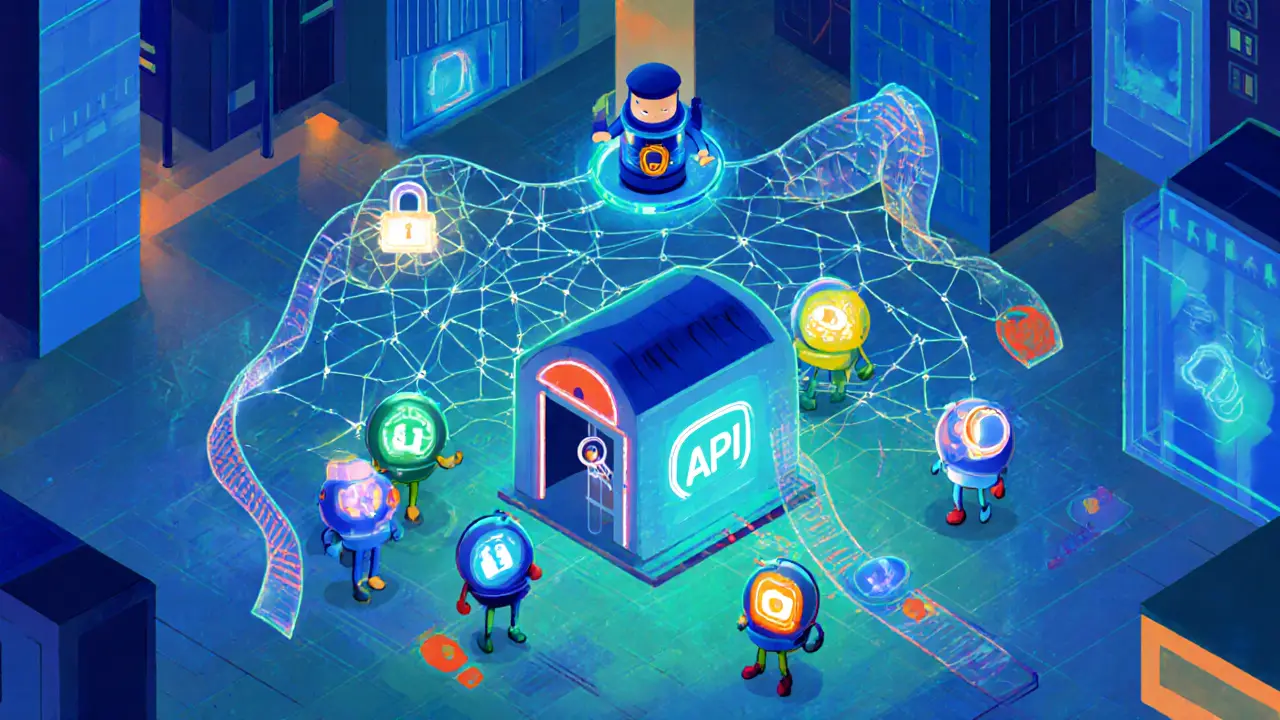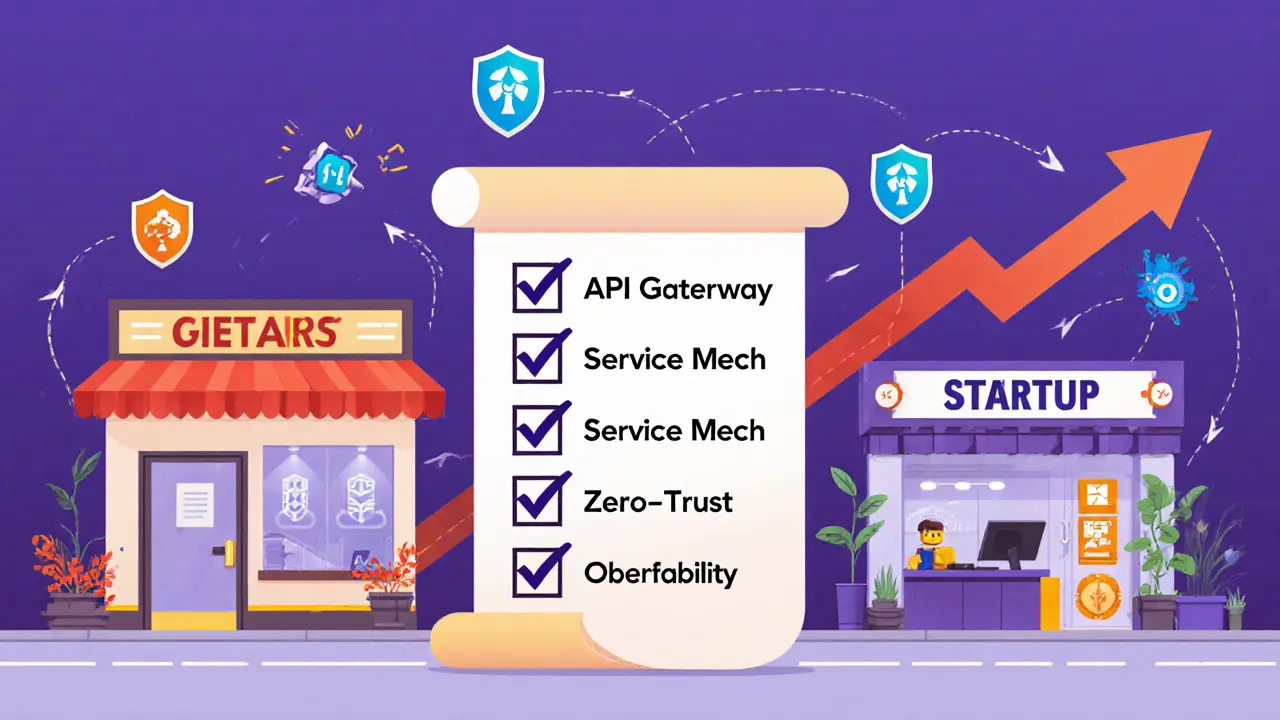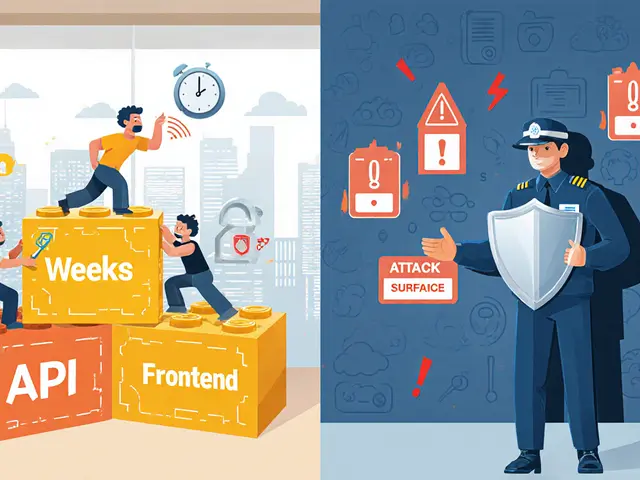Composability vs Security: Balancing Agile Architecture and Protection

Composability vs Security Risk Calculator
Enter values and click Calculate to assess your security risk level.
Key Takeaways
- Composability speeds feature delivery by up to 80% but multiplies the attack surface.
- Microservices, API gateways, and service meshes are essential tools to lock down distributed systems.
- Zero‑trust and observability become non‑negotiable in a composable environment.
- Retail, fintech and fast‑moving startups see the biggest ROI from composable architecture.
- Investing early in security governance pays off with lower breach risk and smoother scaling.
Enterprises are torn between two powerful forces: the agility of composability a design principle that lets you stitch together independent, reusable components through well‑defined APIs and the need for airtight security. The promise is tempting-launch features in weeks, not months-yet each new module, each API endpoint, adds a potential entry point for attackers. This article unpacks the trade‑offs, shows where the balance tips in favor of composability, and equips you with concrete tactics to keep the security gaps at bay.
Understanding Composability
At its core, composability treats software like LEGO blocks. Developers build a system by combining self‑contained services, libraries, or micro‑frontends that expose contracts via REST, GraphQL, or gRPC. The approach emerged from the microservices movement and has been championed by analysts such as CodeStringers (2024) and JetSoftPro (2025). The key benefits are clear:
- Independent teams can iterate without stepping on each other's code.
- Reusable components reduce duplication and technical debt.
- Scaling becomes granular-add resources only where demand spikes.
These advantages translate into real business impact: StepSoftware reports up to an 80% reduction in time‑to‑market for new features, while Contentstack cites a 295% three‑year ROI for composable adopters.
Why Security Becomes Tricky
Every additional service brings its own authentication layer, secret management, and network exposure. JetSoftPro (2025) describes the situation as “multiple moving parts mean multiple attack surfaces.” The main security pain points are:
- Attack surface the sum of all points where an unauthorized user could try to enter or extract data expands dramatically.
- API sprawl the uncontrolled growth of endpoints across services, often leading to hidden dependencies reduces visibility.
- Consistent policy enforcement across services is hard; a mis‑configured service can become a weak link.
Contrast this with a monolithic architecture where authentication, logging, and encryption live in one place, making the security model simpler but the system less flexible.

Composable vs Monolithic: A Comparison
| Aspect | Composable (Microservices, Modular) | Monolithic |
|---|---|---|
| Time‑to‑Market | Up to 80% faster (reusable components, independent pipelines) | Longer cycles; changes require full rebuild |
| Scalability | Granular; scale individual services on demand | Scale whole app, often over‑provisioned |
| Security Model | Distributed; needs API gateways, service mesh, zero‑trust | Centralized; single auth & monitoring point |
| Team Autonomy | High; teams own services end‑to‑end | Low; changes affect entire codebase |
| Operational Overhead | Higher upfront (infra, observability, policy enforcement) | Lower initial setup, but harder to evolve later |
Mitigating Security Risks in a Composable World
Security doesn’t have to be the price you pay for agility. The following building blocks form a defense‑in‑depth strategy.
API Gateways
An API gateway a runtime layer that sits in front of services, handling routing, authentication, rate limiting, and logging centralizes many security concerns. By enforcing OAuth2, JWT validation, and throttling at the edge, you reduce the need to duplicate checks inside each microservice.
Service Mesh
A service mesh an infrastructure layer that manages service‑to‑service communication, providing mutual TLS, traffic policy, and observability such as Istio or Linkerd automatically encrypts inter‑service traffic and offers fine‑grained access control.
Zero‑Trust Architecture
Zero‑trust treats every component as untrusted until proven otherwise. Implementing zero‑trust a security model that verifies each request, regardless of its origin, using identity and context means no internal network is automatically safe.
Observability Stack
Observability goes beyond simple logging. A combination of distributed tracing capturing end‑to‑end request flows across services to pinpoint latency and failures, metrics, and centralized log aggregation lets you spot anomalous behavior quickly.
Policy‑as‑Code
Tools like OPA (Open Policy Agent) let you encode security rules in version‑controlled files. This means policies travel with code, are testable, and can be automatically enforced at build or runtime.
When the Trade‑off Favors Composability
Not every organization should sprint toward a micro‑service garden. The sweet spot appears where speed, scalability, and frequent releases outweigh the added security effort. Notable examples:
- Retail & E‑commerce: Seasonal promotions and A/B tests demand rapid front‑end changes. A composable stack lets marketing teams push new experiences without waiting for a full release.
- Fintech & Banking: Modular compliance engines can be swapped or upgraded as regulations evolve, while a service mesh guarantees encrypted data flows.
- Start‑ups: Start small with a single service, then add others as you grow, preserving the ability to scale without a massive rewrite.
In each case, the business value of faster iteration and isolated failures justifies the upfront security investment.

Implementation Checklist
- Map all external and internal APIs. Identify attack surface hotspots.
- Select an API gateway and enforce JWT/OAuth2 at the edge.
- Deploy a service mesh that provides mutual TLS for every service‑to‑service call.
- Adopt zero‑trust principles: never trust a network, always verify identity and context.
- Instrument services with distributed tracing (e.g., OpenTelemetry) and aggregate logs centrally.
- Codify security policies with OPA or similar, and run them in CI pipelines.
- Train development teams on secret management, least‑privilege IAM, and secure coding practices.
- Run regular breach‑simulation exercises (purple‑team drills) to validate defenses.
Next Steps and Troubleshooting
If you’re already on a monolith, start by extracting a low‑risk, high‑value component-like a recommendation engine-into its own service. Hook it behind an API gateway and monitor the new traffic patterns. Should you notice latency spikes, verify that mutual TLS certificates are correctly rotated and that tracing data is flowing to your observability platform.
For teams stumbling on policy drift, centralize policy files in a version‑controlled repository and tie them to automated gate checks. A broken policy should fail the build, not slip into production.
Frequently Asked Questions
Does composability always increase security risk?
It raises the number of potential entry points, but with proper tooling-API gateways, service mesh, zero‑trust-and disciplined governance, the risk can be mitigated to a level comparable to monoliths.
What size of organization benefits most from composable architecture?
Fast‑growing firms-retail platforms, fintech startups, and enterprises with heavy integration needs-see the biggest ROI because they need to release features continuously and scale selectively.
How much does the security infrastructure cost?
Initial spend can be 20‑30% higher than a monolith due to gateway licenses, mesh deployment, and observability tools. However, faster delivery and reduced downtime often offset these costs within 12‑18 months.
Can existing monolithic apps be retrofitted for composability?
Yes. Start with domain‑driven design to carve out bounded contexts, then expose them via APIs behind a gateway. Incremental migration avoids big‑bang risk.
What are the most common security mistakes in microservices?
Leaving default credentials, inconsistent TLS enforcement, exposing internal APIs to the public internet, and neglecting centralized logging are the top pitfalls.

Darren Belisle
When you start stitching together independent APIs, you instantly unlock the ability to ship new features in weeks rather than months, but each new endpoint also becomes a potential doorway for attackers, so it’s crucial to adopt a layered security model that starts at the edge and propagates inward, leveraging API gateways for authentication, service meshes for mutual TLS, and zero‑trust principles for continuous verification, all while keeping the development velocity high.
Brian Lisk
Indeed, the trade‑off you described can be quantified by mapping every external and internal API, then assigning a risk weight based on exposure, authentication robustness, and data sensitivity; by feeding that matrix into a risk calculator similar to the one in the article you can prioritize which services need immediate hardening, such as enforcing OAuth2 scopes at the gateway, deploying mutual TLS in the mesh, and integrating OPA policies into CI pipelines, thereby turning what looks like a security nightmare into a manageable, incremental journey that preserves the agility that composability promises.
Don Price
What many don’t realize is that the very vendors pushing API gateways and service meshes are often funded by intelligence agencies seeking to embed backdoors into our critical infrastructure, meaning that every “standard” component you adopt could be a Trojan horse waiting to be activated once the attacker obtains the necessary credentials, so the only truly safe approach is to design your system with complete isolation, air‑gapped verification environments, and exhaustive telemetry that can flag any anomalous handshake before it escalates into a breach.
Dawn van der Helm
🌟 Absolutely! Adding a gateway is like putting a security guard at the front door, but remember to also train that guard to recognize suspicious behavior, otherwise you’ll end up with a friendly face that lets anyone in. 😄
Monafo Janssen
Think of composability as a Lego set: each block is useful on its own, but the more blocks you connect, the more places a piece can fall out if you don’t keep an eye on the joints.
Michael Phillips
That analogy works well; extending it, the “joints” in a micro‑service architecture are the API contracts, and ensuring they are versioned, validated, and monitored is essential to prevent accidental breakage or malicious exploitation.
Jason Duke
While the excitement around rapid deployments is understandable, never lose sight of the fact that security isn’t a checkbox you fill once and forget; it requires continuous reinforcement, periodic audits, and a culture where every engineer treats security as a shared responsibility, not just the domain of a dedicated team.
Bryan Alexander
Imagine a world where every new feature you roll out instantly becomes a beacon for cyber‑pirates, lighting up the night sky with alarms and alerts; that’s the reality if you sacrifice thorough threat modeling on the altar of speed-so harness the drama, but channel it into disciplined testing and robust observability!
Patrick Gullion
Speed and security can coexist.
Jack Stiles
Totally agree, man-just make sure you’ve got the logs set up right, otherwise you’ll be chasing ghosts.
Ritu Srivastava
From an ethical standpoint, organizations that rush to adopt composable architectures without embedding security from the ground up are essentially putting the public’s data at risk for the sake of market advantage, and that decision violates the fundamental principle of doing no harm that underpins responsible technologists; moreover, regulations such as GDPR and CCPA impose heavy fines for data breaches, meaning that shortcuts in security can translate directly into financial loss and reputational damage; the moral imperative is therefore clear: prioritize protecting user privacy before chasing shiny features; by implementing zero‑trust frameworks, companies demonstrate a commitment to safeguarding personal information, which in turn builds trust with customers and partners; instead of viewing security as a hindrance, treat it as a competitive differentiator that can be marketed to privacy‑conscious users; investing in robust authentication, encrypted communication, and continuous monitoring not only mitigates risk but also reduces the long‑term costs associated with incident response; furthermore, a culture of security awareness empowers developers to write safer code, reducing the likelihood of vulnerabilities slipping into production; this cultural shift also encourages cross‑team collaboration, aligning security, operations, and product teams around shared goals; the long‑term payoff includes lower downtime, better compliance scores, and a stronger brand reputation; in sum, the ethical duty to protect data aligns with sound business strategy, creating a win‑win scenario; neglecting this duty not only endangers users but also exposes the organization to legal consequences and loss of market confidence; therefore, make security an integral part of the composable journey from day one, and you’ll reap both moral and monetary benefits; by auditing your security posture quarterly, you catch drift before it becomes a breach; continuous training ensures that new hires inherit the same security mindset; ultimately, a secure composable system is not a myth-it is achievable with disciplined practice.
Liam Wells
While your moral exposition is comprehensive, it would be remiss not to acknowledge that the practical implementation of zero‑trust across heterogeneous services introduces substantial operational overhead, necessitating a judicious balance between theoretical idealism and pragmatic resource allocation.
Caleb Shepherd
Totally see your point-just remember to keep the policy‑as‑code files in version control so every change gets a proper PR review, that way you blend the ethical drive with real‑world DevOps practices.